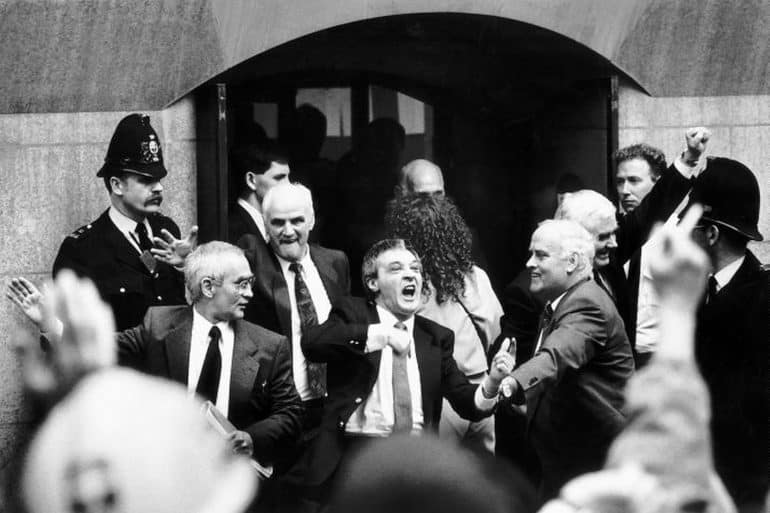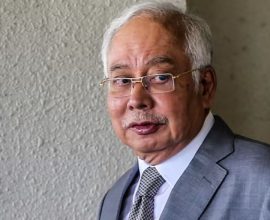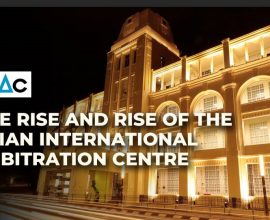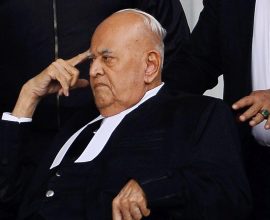What do the Altantuya’s case, Lord Denning and the Birmingham Bombers have in common?
Quite a few things, actually. The first is the presence of explosive material. Second, whether the case could be re-opened. Read on …
The Birmingham Bombers’ case in itself throws up interesting questions:
‘Do the best of judges tend to overlook police complicity in some cases?’
‘Can a court re-open a criminal case?’
‘Can a new actor be charged for an old crime?’
We start with what happened in Birmingham on 21 November 1974. It had to do with the Provisional IRA.
‘At eight minutes past eight…’
Lord Denning describes it.1McIlkenny v. Chief Constable of West Midlands Police Force and Another [1980] 2 All ER 227 at 231
‘Eight minutes past eight in the evening. The telephone rang in a newspaper office in Birmingham.’
The caller identified two public houses in which bombs had been placed.
The bombs went off, killing 21 people and injuring 161.
These ‘Birmingham Bombings’, as they came to be called, were attributed to the Provisional IRA.
The Birmingham Six
The police discovered that a train had left New Street for Belfast 20 minutes before the blast. The police stopped anyone who got off that train.
They arrested six men. They were the ‘Birmingham Six’.2Patrick Joseph Hill, Gerard Hunter, Richard McIlkinney, William Power and John Walker, and Hugh Callaghan.
These men, it later emerged, had all planned to attend the funeral of one James McDade, a known IRA bomb maker. In an unrelated event in Coventry a week earlier, he had blown himself up. This, naturally, spiked police suspicions.
Were the men beaten into confessing?
On 23 November 1974, two days after the bombing, the police interviewed the Birmingham Six.
The men, says Denning,
‘[Admitted] their part in placing the bombs’.
When the men appeared before the magistrate on 28 November 1974, Lord Denning records,
‘[At] their appearance, there were gasps of astonishment. They had all been beaten up. Their faces were black and blue. …The papers were full of it. The men were again remanded in custody’.3Ibid, p.232
By 08 December 1974, the Home Office was so concerned that it asked Mr Owen, a Lincolnshire police officer, to conduct an enquiry.
Amazingly, his reports were never produced in court.
At their trial, the Birmingham Six had protested that:4It commenced on 09 June 1975
‘[They] had been induced [to confess] by violence and threats made by the police to them.’5Ibid, p.33
No evidence even to charge them…
Denning concedes that,
‘The police had no sufficient evidence on which to charge the men, let alone convict them. There was nothing but suspicion of the vaguest kind quite unsupported by any concrete evidence. So the statements were vital. Were they obtained voluntarily or not? That was the decisive point at the trial.’6Ibid, McIlkinney, p. 232
The trial judge came to this conclusion:
‘… it is an inescapable conclusion that there is gross perjury being committed on the one side or the other.’
These ‘lies’ were all concerned with the injuries on the men. The question that all the judges seemed to have asked themselves was, at which point had these injuries been sustained: before or after their confessions?
If they had sustained the injuries before the confessions, the confessions would fall. This also meant that the police had inflicted the injuries.
If the men had sustained their injuries while awaiting trial at Birmingham’s Winson Green Prison, that would not have affected the confessions.
So the arguments went.
The trial court rules and the Court of Appeal agrees
At trial Bridge J ruled the police documents admissible, and on that basis alone the jury convicted each man on 21 counts of murder.7Ibid, p. 233 The Court of Appeal upheld the convictions.
They were all sentenced to life imprisonment.
If the police had not beaten up the six, who had?
What if the police officers were right?
It meant only that the Winson Green Prison officers could have beaten the men up.
So they were charged.8On 30th November 197589
At their trial, an expert, Dr David Paul, testified that the men had been injured whilst they were in police custody.
His testimony was adverse to the police.
And each prison officer testified that each of the six prisoners had been,
‘[Bruised] and injured when they arrived at the prison’.10Ibid,p.234
The prison officers were all acquitted.
The Birmingham Six sue the Police
The Birmingham Six now filed four civil suits against the police and the UK Home Office.
The men said they now had ‘new evidence’ that it was the police who were responsible for their injuries.
The Police argue the case cannot be re-opened – ‘estoppel’
The police said the courts should kick out these ‘abusive’ civil actions.
They pointed to the criminal trial, where Bridge J had already ruled that the police had not injured the men.
The police made two legal points: (1) ‘estoppel’ and (2) abuse of process.
Estoppel is a Norman import into Britain. It means, ‘stopped’.11
If you want to know more about ‘Estoppel’…
If you want to learn more about estoppel, see how Denning explains it beautifully as a house with many rooms, in each of which there are rickety and untrustworthy chairs, as well as alcoves.12Ibid, p. 235 et. seq
High Court dismisses the civil action against police officers
At the High Court, Cantley J dismissed the civil cases.13This was in November 1977
Appeal before Denning
Their appeals ended up at the Court of Appeal.14Before Lord Justices Denning, Goff and George Baker on 12 November 1980
The hearing went on for 12 days, amidst a blaze of publicity – something which Lord Denning did not avoid too much.
The Doctrine of Finality – and the ‘against’ principle
This doctrine, described as ‘issue estoppel’, can be explained in this way:
Suppose a previous case had made a ‘final’ decision against a man.
In the earlier case, he had had ‘a full and fair opportunity in defending himself’.
If so, it would be unfair or unjust to allow him to re-open a case which had decided against him.15 House of Lords in Carl-Zeiss Stiftung v. Rayner and Keeler Ltd (No.2) [1966] 2 All ER 536 at 554 The decision was ‘final’.
The courts have consistently ruled that the ‘overriding consideration’ of the estoppel principle is ‘to work justice’.16Ibid at Carl-Zeiss, at p. 573
In Malaysia, the courts have repeatedly held that they cannot re-open appeals.17Lye Thai Sang & Anor v. Faber Merlin (M) Sdn Bhd & Ors[1986] 1 MLJ 166; and Dato Seri Anwar bin Ibrahim v. Public Prosecutor [2004] 3 MLJ 517
So also in Singapore.18Abdullah bin A. Rahman v. Public Prosecutor [1994] 3 SLR 125 [CA]; and Lim Choon Chye v. Public Prosecutor [1994] 3 SLR 135. See also Jack Lee Tsen-Ta, ‘The Court of Appeal’s Lack of Jurisdiction to Reopen appeals: Abdullah bin Rahman v. PP; Lim Choon Chye v. PP’, Singapore Journal of Legal Studies, (December 1994) pp. 431-447, National University of Singapore
But there are exceptions: fraud or collusion
However, Denning acknowledged the existence of a 240-year-old law that if it could be proven that a decision had been obtained ‘by fraud or collusion’, a court could re-open a ‘closed case’.19Duchess of Kingston’s Case (1776) 2 Smith’s LC (13th Ed) 644 at 652, [1775-1802] All ER 623 at 630, which Denning cites in McIlkenny, at p.237. This was reconfirmed in by the Malaysian Federal Court in Dato Seri Anwar bin Ibrahim v. Public Prosecutor [2004] 3 MLJ 517, at p. 527, and p. 531, para[44], and the dissenting opinion of Steve Shim CJ (Sabah and Sarawak) in Lye Thai Sang & Anor v. Faber Merlin (M) Sdn Bhd & Ors[1986] 1 MLJ 166 at pp 684-685.
Second exception – New Evidence
A court could also re-open a case if new evidence – previously unavailable – is produced.20 Phosphate Sewage Co v. Molleson (1879) 2 AC 801, at 804, per Earl Cairns LC which Denning MR cites in McIlkenny, at p.237 Yet Denning emphasises that the quality of the new evidence must be ‘conclusive’ or ‘decisive’.21 Brown v. Dean [1910] AC 373 at 374, see also McIlkenny, at p.237
He said it is a far stricter test than that of introducing new evidence on appeal.22Ladd v. Marshall [1954] 3 All ER 754 and Skone v. Skone [1971] 2 All ER 582: see Denning MR in McIlkenny, at p.237. A 1968 English statute also states that a previous conviction can be referred to in a subsequent civil case to prove that the accused committed the crime, ‘unless the contrary is proved’. UK’s Civil Evidence Act 1968, sec. 11 ‘Proven to the contrary’ said Denning, meant the accused must prove that his previous conviction had been obtained ‘by fraud or collusion’, or by showing ‘conclusive’ new evidence.23See Ibid, p.237
Denning writes an epitaph for himself and British Justice
Having analysed the law in so exemplary a manner, Lord Denning concluded with two signature passages.
Truth be told, seven judges sided with him. Yet to him alone will history turn its eye of judgment, when he said:24 A Benchmark of British Justice; see https://www.theguardian.com/news/1999/mar/06/guardianobituaries
‘If the six men win, it will mean . . . that the convictions were erroneous. That would mean that the Home Secretary would either have to recommend they be pardoned, or he would have to remit the case to the Court of Appeal . . . This is such an appalling vista that every sensible person in the land would say it cannot be right that these actions should go any further.25see Denning MR in McIlkenny, at p.239, paras ‘g’ to ‘j’
Denning who had a strong authoritarian approach to public order,26 https://www.theguardian.com/news/1999/mar/06/guardianobituaries then makes this stupendous statement:-
‘This case shows what a civilised country we are. Here are six men who have been proved guilty of the most wicked murder of 21 innocent people. They have no money. … Yet the state continues to lavish large sums of money on them, in their actions against the police. It is high time that is stopped. It is really an attempt to set aside the convictions by a side wind. It is a scandal that it should not be allowed to continue.’
Lord Denning struck out the civil cases.
Gareth Peirce’s stamina, Granada TV & the Mullin book
It would be an unfair writer who omits to refer to the inflexible will of a solicitor for the Birmingham Six, Ms. Gareth Peirce.27 She was once called ‘the doyenne of British defence lawyers’, and one who ‘refuses to be defeated … no matter how unfavourable it looks’. Sir Ludovic Kennedy, Alderson, Andrew; Goswami, Nina (5 August 2005). The Sunday Telegraph. London. Peirce is said to have ‘transformed the criminal justice scene in this country almost single-handedly’.Benedict Birnberg, who first employed her as a solicitor. ‘Gareth Peirce: Tough case’. The Independent. London. 4 August 2002. Archived original dated 4 June 2011. She shunned the limelight and refused media interviews. When she was to be awarded the CBE for ‘services to justice’, she declined it. See http://news.bbc.co.uk/2/hi/uk_news/275676.stm . A journalist before she became a solicitor, on 11 March 2011, Peirce she wrote a blistering piece,‘The Birmingham Six: What have we learned from our disgraceful past?’ https://www.theguardian.com/theguardian/2011/mar/12/gareth-peirce-birmingham-six . There she recounts the suffering of the men and their families: the latter often had to flee numerous times to escape a campaign of bullying and terror carried out by members of the public. There are other insightful references about her: See, e.g. https://www.bbc.com/news/uk-england-birmingham-47670167 and, ‘Gareth Peirce: Why I still fight for human rights’ by Jeffries, Stuart at https://www.theguardian.com/law/2010/oct/12/gareth-peirce-fight-human-rights
When the hardest of the hardiest would have stopped, Peirce pressed on. Because of this, in 1986 Granada Television ran a programme. It was based on a book by Chris Mullins, ‘Error of Judgement’.
This prompted the Home Department to refer the case back to the Court of Appeal.28 Under sec 17(1)(a) of the Criminal Appeal Act 1968 On Jan 1988, that appeal was dismissed.
Fourth Round
In February 1990 the case was – for the second time – referred to the Home Secretary.29R. McIlkenny and Others [1991] LRC (Crim) 196, per Lloyd, Mustill and Farquharson LJJ
Fresh Evidence had become available. The DPP indicated that he would not resist the appeals.
A new test for re-opening cases: ‘Is the conviction safe and satisfactory?’
The Court of Appeal said it should ask itself, ‘if the convictions were safe and satisfactory’.
If the answer was ‘No’, then the convictions had to be quashed.30citing Stafford v DPP [1973] 3 All ER 762; Luvaglio v DPP and [1974] AC 878 – per Lloyd, Mustill and Farquharson LJJ in R. McIlkenny at p. 212 The courts had used a similar test in the Guildford Four and other cases.31R v. Richardson; Rv. Conlan; R v. Armstrong; R v. Hill: (1989) Times, 20 October; R v. Khan (1990) The Independent 2 March; and R v. Edwards [1991] 2 All ER 266 [1991] 1 WLR 207. Until 2014 at least that has been accepted as a correct test: R v. Foran (Martin Patrick) [2014] [CA] Criminal Division
This 1991 test is still current: and it in no way weakens the 1980 Denning decision, which spoke of fraud, collusion or the availability of new evidence – but we shall return to this at the end.32 McIlkenny v. Chief Constable of West Midlands Police Force and Another [1980] 2 All ER 227
The 1991 Court of Appeal referred to two pieces of new evidence.
First, one Dr Skuse had conducted a scientific analysis. He concluded the men had tested positive for nitro-glycerine, an explosive material.
But it was proven that even some ordinary soaps and detergents could give a positive result under the Skuse test.
Second, electrostatic document analysis (ESDA) of police notebooks showed that the notes of interviews could not have been made contemporaneously – this was contrary to what the police had said during the trial.
The ESDA test showed up indentations made on the top sheets. These impressions were carried through to the following pages. The police notebooks failed to show this consistency.
So the confessions could not have been made at the time they were arrested.
This meant, said the judges, ‘either the police officers had lied at the trial, or they had fabricated either part or all of the interviews’.33Ibid, p. 205
The Court felt that the evidence left to the jury depended heavily on scientific evidence of Dr Skuse, and the ESDA evidence of the police notepads.
Dr Skuse’s evidence was, said the court, ‘now in doubt’.
As for the police evidence, the court held that the police witnesses ‘were at least guilty of deceiving the court’.34Ibid, p. 213 paragraphs ‘a’ to ‘c’.
Third, the confessions were so inconsistent in their intrinsic details that they were unreliable:35Ibid paragraph ‘d’ e.g. according to the confessions, the accused Hunter would have been at two places simultaneously.36Ibid
Hence the prosecution case would have very probably failed, the court ruled.37R v Lattimore (1975) 62 Cr App R 53, or the ‘Confait’ case
The court asked itself: how would this fresh evidence have affected the jury?
The court felt the fresh evidence would have destroyed the police case.
The judges felt that the convictions were ‘unsafe and unsatisfactory’.38Ibid pp. 213 and 214
They quashed the conviction.
After 16 years – a lifetime – the men were freed on 14 March 1991. The cover photograph says it all.
Paddy Hill, [in the words of Peirce] ‘whose 16-year anger had scorched a path to freedom’ said afterwards,
‘The Police stated that from the start, they knew we hadn’t done it.’
Aftermath
Denning died in 1999, aged 100.
The Birmingham Six were awarded damages ranging from £840,000 to £1.2 million.
In a 2019 inquest into the deaths of the 21 victims, ‘Witness O’, a convicted IRA bomber, named four other men he said were responsible for the 1974 Birmingham pub bombings.39 He named the perpetrators as Seamus McLoughlin, Mick Murray, Michael Hayes and James Gavin. See https://news.sky.com/story/birmingham-pub-bombings-ira-witness-names-four-men-he-says-were-behind-attacks-11672571[/mfn] And now to Malaysia, and the Altantuya case On 09 April 2009, after a 159-day trial, Inspector Azilah bin Hadri and Corporal Sirul Azhar bin Hj Umar, were convicted of murdering a Mongolian – Ms. Altantuya Shaaribuu. They were both members of the elite Special Action Unit [UTK] of the Royal Malaysian Police Force.39Public Prosecutor v. Azilah bin Hadri & Anor [2015] 1 MLJ 617
The prosecution’s case was largely based on circumstantial evidence. Altantuya was abducted and killed. The cause of Altantuya’s death was said to be ‘blast-related injuries’.40Ibid, p.269, para [135] Why was she killed? No one tells us.
The trial judge records that,
‘Whoever perpetrated this despicable and unthinkable act of blasting on the accused must have intended to completely vanish the related evidence into the thin air (sic).’41Ibid p. 270, para [137]
Evidence – most of which looked suspiciously like confession evidence – was thrown in to support the prosecution case. Defence counsel protested. Most such evidence was thrown out.
Cpl. Sirul’s defence was that he had been made a scapegoat.
Convicted and sentenced to death
At the end of the trial they were convicted and sentenced to death.
Court of Appeal acquits them
On appeal to the Court of Appeal, the court held that the ‘chain of evidence [was] not complete.’ 42 Azilah bin Hadri & Anor v. Public Prosecutor and another appeal [2013] 5 MLJ 309, p. 345, para [109]
The Court of Appeal ruled that the trial judge had failed to adequately evaluate Azilah’s defence of alibi.
The court points out various inadequacies in the prosecution case.
Evidence of telephone call logs was unreliable. The prosecution ‘could not connect the accused to the scene of the crime’.
The police argued they had ‘discovered’ various pieces of evidence in vehicles or places. As for these police ‘discoveries’, the Court of Appeal felt that the trial court had failed to examine the ‘credibility of the police witnesses’.
Materials found in the accused’s car (such as the deceased’s blood-stained slippers and bullet shell casings) created ‘gaps’. These, said the Court of Appeal, cast doubt; for the vehicles had been in police control before the material was found.
There was also no evidence of any connection between the explosive material and the accused.
Again, one senior officer Musa had directed the accused to patrol a particular area, which the victim had visited, and from which she had disappeared. Musa had not been called as a witness.
Generally, there was no connection between the ‘discovered evidence’ and the accused.
There is a sense in that judgement that the prosecution had been less than perfect.
The convictions were quashed, and the men were acquitted and released.43
The prosecution appeals to the Federal Court – they are convicted and sentenced to death, again
By this time, Sirul had slipped out to Australia.
After a final appeal, the apex court restored and affirmed the decision of the High Court.
The convictions – and the mandatory death sentence – were upheld.
And here is the thing – why was Altantuya murdered?
There is a point in his judgement at which the trial judge utters these intriguing words:
‘I may endlessly ask [myself] why, why, why?’44 Public Prosecutor v. Azimah bin Hadri & Ors [2012] 8 MLJ 222, at p. 270 paragraph [138]
He had many good reasons to ask himself this question.
“No one knows – to this day – why two men, who were wholly unconnected with Altantuya, and who were complete strangers to her, would want to kill her, and did kill her.
The court gives no reason. There is no official version. A lawyer, Americk Sidhu, has written about it, here.
Contradictory statements
From the relative safety of his Australian prison, Sirul has issued contradictory statements.
Recently, Azilah has begun to point a finger at a third party.
Can the case be reopened? Is there no other way?
There is.45Jack Lee Tsen-Ta argues that ‘there is no satisfactory process by which miscarriages of justice can be corrected’: Supra,‘The Court of Appeal’s Lack of Jurisdiction to Reopen appeals: Abdullah bin Rahman v. PP; Lim Choon Chye v. PP’, Singapore Journal of Legal Studies, (December 1994) pp. 431-447, National University of Singapore p.435. He suggests a way. It is in sec 5 of the Criminal Procedure Code in Malaysia. In Singapore this provision is in sec. 6 of the CPC (Chapter 68)(Rev 2012). Under sec 5 CPC, if Malaysian written law is silent ‘on matters of criminal procedure’, one can import English law ‘relating to criminal procedure’ – but only if it would ‘not conflict or be inconsistent with’ the Malaysian Criminal Procedure Code.
One local provision suggests we could import UK law if it is not in conflict with local law. 46Sec 5 Criminal Procedure Code [Malaysia]
Unfortunately, UK has repealed the law under which the Birmingham Six had proceeded.47Criminal Appeals Act 1968 In 1995 the UK passed a new law. 48 Criminal Appeals Act. It established a Criminal Cases Review Commission. 49 Under sec.8 of that Act The Commission has the power to send a case back to an appeals court if it concludes ‘there is a real possibility that the court will overturn a conviction or reduce a sentence’.
Since 1997, the UK Commission sends just over 30 cases a year to the courts. More than 60% succeed.
We have no such law, or Commission, here. So there’s the rub.
We can pass a law similar to the UK Criminal Appeals Act 1995.
That will take time. It will also be difficult to use it for past crimes, as this one.
But really, the Federal Court has already determined that where there is fraud or collusion, or new evidence, a case can be re-opened.50See Malaysian Federal Court in Dato Seri Anwar bin Ibrahim v. Public Prosecutor [2004] 3 MLJ 517, at p. 527, and p. 531, para[44], and the dissenting opinion of Steve Shim CJ (Sabah and Sarawak) in Lye Thai Sang & Anor v. Faber Merlin (M) Sdn Bhd & Ors[1986] 1 MLJ 166 at pp 684-685.
It is now in the hands of the AG
Whether the courts will re-open the case depends very much on what the Attorney General will do.
The right to prosecute is that of the AG alone.
Banquo’s Ghost – who will give justice to Altantuya’s restless spirit?
The question of why Altantuya was murdered, like a Damoclean sword, keeps descending upon the nation. If that question is answered, it will dispel much of the mystery surrounding her death. In the Shakespearean play, Macbeth gives secret orders for Banquo to be killed. Banquo is stabbed 20 times and left for dead. Meanwhile Macbeth organises a dinner for some honoured guests. There, word reaches him that Banquo is dead. With him is Lady Macbeth, whose hands are not entirely spotless. Suddenly Macbeth sees Banquo’s ghost seated at the table. That foretells that all is not well in the kingdom, that judgement is nigh, and that someone else will inherit the throne. It is as if Shakespeare had Malaysia had in mind when he wrote Macbeth four centuries ago.51Act 3, Scene 4
“Until such time as her death is avenged, like Banquo’s ghost, the apparition of Altantuya points a terrible – and accusing finger – at a whole nation.
Who will give justice – and repose – to Altantuya’s tormented spirit?





